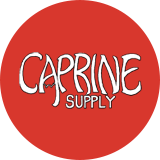Recognizing a Good Dairy Goat
A "good dairy goat" is not just a doe with a pretty udder or one that milks 4,000 pounds a year. A "good dairy goat" must have a combination of positive qualities, all of which allow her to produce lots of milk, have numerous kids, and live a long productive life. Many traits go together to make a "good" goat, and if you learn to recognize these traits, you'll be able to improve your breeding program and purchase better goats.
No matter what some-one tells you, no one can look at a young kid and tell that she'll be a permanent champion or have great udder attachment, but you can learn to recognize certain positive traits that does of all ages can possess.
The first thing that hits your eye is general appearance. Structurally, the doe should have a strong, level top line; her withers should blend smoothly into the shoulder blades (no bumps or humps as you run your hand down her neck over her withers and shoulders). Her front legs should be wide apart, strong, and straight (not curved as you look at them from the side); her rear legs should be set wide apart at the hocks, with a wide arched opening in the escutcheon area. As you look at her rear legs from the side, they should be nearly perpendicular from hock to pastern. Look for short, strong pasterns, not ones that are broken and weak. Does with these positive structural traits should be productive does; they will have the strength to withstand the rigors of heavy milking and strenuous kid bearing for many years.
Dairy character is also important. A doe should look feminine; she should walk with gracefulness and animation. She should be an "open" doe - her ribs should be set wide apart; they should be flat (as should all her bones) and long. To feel the difference between flat-boned and round-boned does, run your hands down the ribs of a number of does. Flat-boned does? bones actually feel flatter; the space between ribs will usually be wider. The more times you do this, the easier finding that flat-boned doe will be. With more experience, you'll actually be able to pick out "dairy" does from across the barn or ring; they ooze femininity, angularity, and, well, dairyness.
A "good" doe has body capacity, and you can see some of this potential capacity even in kids. Look for a doe with deep heart girth (more room for the lungs and heart). In small kids, look also for width of the chest floor; a really narrow, pinched kid will never develop tremendous body capacity. When choosing a kid, don't worry about size of barrel as much as body length in general. In older does, look for increasing depth from front to rear as you look from the side. Remember that large body capacity means more room for food and for kids. Be careful, though, not to mistake a fat, beefy doe for a capacious doe. You're looking for a doe with body capacity and dairy character.
For a doe to milk well over a long lifetime, she'll need to have a well-attached udder. Udders without much attachment tend to flop around, get stepped on, and generally are more prone to injury and disease than udders that have strong attachments. Look for a high, wide rear udder attachment and ideally a smooth, well-extended fore udder. A doe can have a small pocket in the fore udder, though, and still have a functional udder - if she has strong rear udder attachment and a correctly attached medial suspensory ligament. The smooth fore udder is icing on the cake. The medial suspensory ligament is the udder's primary support; if it's weak, the whole udder will sag. Finally, the udder must be capacious (that means large in relation to the doe's size), and when the doe is milked out, ideally there should not be a whole lot of "beef" or "meat" in the udder. The more there is, the less capacity there is for milk.
Why do you need to know what a "good goat" looks like? Remember, it costs the same to feed a structurally sound goat as an unsound one, and a "good doe" will give you many more years of service, more milk, and more kids, with fewer health problems. However, no matter how structurally sound a goat is, if she doesn't have good management, she'll never reach her potential. So you must give your "good does" a sound program of health care, feeding, and general maintenance, to insure that they live up to their potential.

Log In